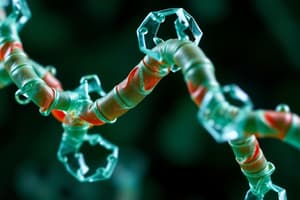Podcast
Questions and Answers
What is the term for the protein part of an enzyme?
What is the term for the protein part of an enzyme?
- Apoenzyme (correct)
- Cofactor
- Holoenzyme
- Substrate
Which statement correctly defines the optimum temperature for an enzyme?
Which statement correctly defines the optimum temperature for an enzyme?
- Temperature where no enzyme activity occurs
- Temperature that activates substrate
- Temperature that maximizes enzyme activity (correct)
- Temperature at which enzyme denatures
What does Km signify in enzyme kinetics?
What does Km signify in enzyme kinetics?
- Rate of product formation
- Maximum reaction speed
- Temperature sensitivity of the enzyme
- Enzyme's affinity for the substrate (correct)
Which of the following factors does NOT affect enzyme activity?
Which of the following factors does NOT affect enzyme activity?
What is the characteristic of reversible inhibitors?
What is the characteristic of reversible inhibitors?
What defines the unit of enzyme activity?
What defines the unit of enzyme activity?
Which type of inhibitor permanently decreases enzyme activity?
Which type of inhibitor permanently decreases enzyme activity?
What is the effect of pH on enzyme activity?
What is the effect of pH on enzyme activity?
What is the primary function of enzymes?
What is the primary function of enzymes?
Which type of enzymes are specifically known as ribozymes?
Which type of enzymes are specifically known as ribozymes?
Which enzyme classification is NOT correctly placed in the order?
Which enzyme classification is NOT correctly placed in the order?
What does the term 'substrate specificity' refer to in the context of enzymes?
What does the term 'substrate specificity' refer to in the context of enzymes?
What is the efficiency range of enzyme-catalyzed reactions compared to uncatalyzed reactions?
What is the efficiency range of enzyme-catalyzed reactions compared to uncatalyzed reactions?
Which of the following is a true statement about the action of enzymes?
Which of the following is a true statement about the action of enzymes?
What aspect is affected by the catalytic activity of an enzyme?
What aspect is affected by the catalytic activity of an enzyme?
Which of the following enzymes is considered one of the fastest known?
Which of the following enzymes is considered one of the fastest known?
Flashcards
Enzyme
Enzyme
A biological catalyst that speeds up chemical reactions.
Activation Energy
Activation Energy
The minimum energy needed for a reaction to occur.
Enzyme Specificity
Enzyme Specificity
Enzymes usually work on only one type of molecule or a few very specific ones.
Enzyme Efficiency
Enzyme Efficiency
Signup and view all the flashcards
Enzyme Classification
Enzyme Classification
Signup and view all the flashcards
Catalysts
Catalysts
Signup and view all the flashcards
Enzyme Inhibition
Enzyme Inhibition
Signup and view all the flashcards
Enzyme Classification Categories
Enzyme Classification Categories
Signup and view all the flashcards
Enzyme Activity
Enzyme Activity
Signup and view all the flashcards
Enzyme Concentration
Enzyme Concentration
Signup and view all the flashcards
Substrate Concentration
Substrate Concentration
Signup and view all the flashcards
Optimum Temperature
Optimum Temperature
Signup and view all the flashcards
Optimum pH
Optimum pH
Signup and view all the flashcards
Km
Km
Signup and view all the flashcards
Holoenzyme
Holoenzyme
Signup and view all the flashcards
Study Notes
Learning Objectives
- Describe enzymes and their common properties
- List enzyme classifications in correct order
- Describe factors that change enzyme activity
- Explain the relationship between Km and activity
- Explain enzyme inhibition and inhibition types
Metabolic Reactions
- Enzymes facilitate metabolic reactions
- Enzymes speed up reactions by lowering activation energy
- Enzymes alter the rate and change the classic biochemical reaction
- Enzymes facilitate transport of molecules
Glycolysis
- Glycolysis is a metabolic pathway for glucose breakdown
- Enzymes like hexokinase and phosphofructokinase are key in glycolysis
- Chemical reactions in glycolysis are shown in diagrams.
Activation Energy
- Activation energy is the energy needed for a reaction
- Catalysts, like enzymes, lower the activation energy, increasing reaction rates.
- Enzymes do not cause a chemical or nuclear reaction, but rather speed up an existing one.
Activation Energy and Catalysts
- Catalysts increase reaction rate without being consumed
- Catalysts decrease activation energy, making reactions easier
- Enzymes are biological catalysts
Enzymes
- Enzymes are biological catalysts
- Enzymes increase reaction rate by lowering activation energy
- Enzymes bind to substrates—reactants—to make products.
Properties of Enzymes
- Most enzymes are proteins
- Ribozymes are RNA enzymes
- Enzymes change reaction rate
- They are specific for substrates and reactions.
Efficiency
- Enzyme-catalyzed reactions are much faster than uncatalyzed reactions
- Carbonic anhydrase is a very fast enzyme, hydrating CO2
- Enzymes are highly efficient
Specificity
- Reaction specificity means enzymes catalyze specific reactions
- Substrate specificity means enzymes work on specific substrates or related molecules
Enzyme Nomenclature: Classification
- Enzymes are classified using an EC number
- Classification groups enzymes by function
- This classification system provides a hierarchical structure for enzymes.
Enzyme Kinetics and Km
- Km is a measure of enzyme affinity for substrate
- High Km means low affinity
- Enzymes work quickly and efficiently at high substrate concentration.
- Affinity and binding power are affected by substrate concentration.
Km, A Clinical Example
- Km is used to assess the efficiency of enzymes in clinical situations.
- Enzymes efficiency is relevant to the toxicity of substances.
Regulation of Enzyme Activity
- Enzyme activity can be regulated through multiple mechanisms.
- Enzyme amount (synthesis and degradation)
- Enzyme modification (covalent and non-covalent)
- Isozymes and compartments
- Feed-forward activation and feedback inhibition are important regulatory processes.
- These regulatory mechanisms allow the body to adjust enzyme activity based on cellular needs.
Enzyme Structure
- Apoenzyme: protein part of an enzyme
- Cofactor: non-protein part of an enzyme
- Holoenzyme: complete catalytically active enzyme
- Active site: where substrates bind and reactions occur.
Enzyme Structure: Active Site
- Active sites are highly specific for substrates
- Amino acid residues in the active site interact with substrates
Enzyme Activity
- Enzyme activity is measured by the rate of product formation
- One unit of enzyme activity converts one µmole of substrate to product
- Reaction speed depends on the number of substrates that change into products.
Factors Effecting Enzyme Activity
- Enzyme concentration affects the speed of a reaction
- Substrate concentration affects how quickly substrates move into reactants
- Temperature changes enzyme structure, and affects activity
- pH changes can affect enzyme activity
- Inhibitors can decrease reaction speed and are important to understanding enzyme functions.
Enzyme Concentration
- Enzyme concentration directly impacts reaction speed
- Increasing enzyme concentration increases the rate at which substrates can be converted to products
Substrate Concentration
- Increasing substrate concentration increases reaction speed until maximum rate is reached
- Km, the substrate concentration at half maximum reaction rate, reflects enzyme affinity for a substrate
Temperature
- Temperature affects enzyme shape and activity
- Enzymes have optimal temperatures for maximum activity
- Extreme temperatures can denature enzymes, stopping reactions.
pH
- pH affects enzyme shape and activity
- Enzymes have optimal pH ranges
- Extreme pH values can denature enzymes
Inhibitors
- Inhibitors decrease enzyme activity
- Reversible inhibitors bind temporarily
- Irreversible inhibitors bind permanently
Studying That Suits You
Use AI to generate personalized quizzes and flashcards to suit your learning preferences.




